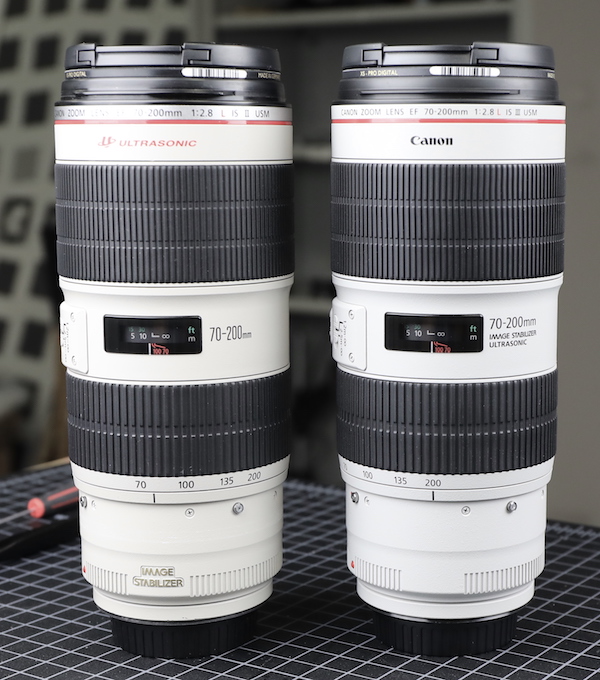Equipment
Lens Teardowns and Comparisons of the Canon 70-200mm f2.8 IS II and III
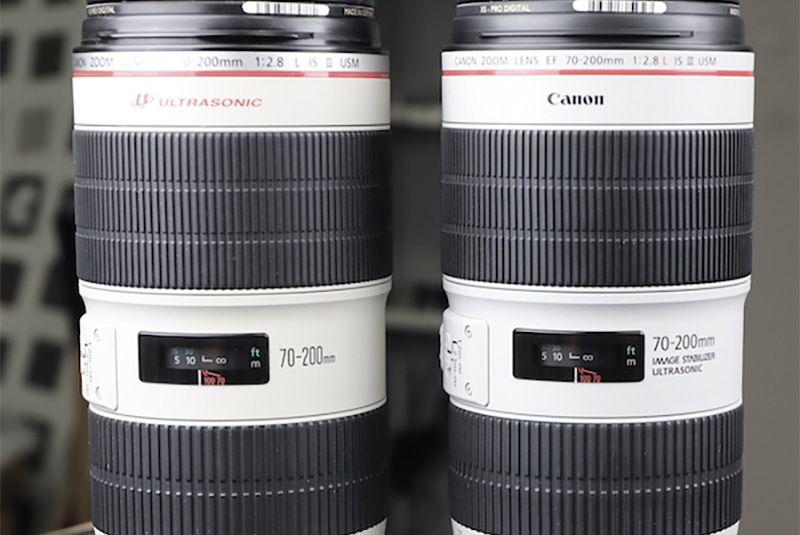
Years ago, I introduced Roger’s Law of New Product Introduction AKA The Fanboy Uncertainty Principle.
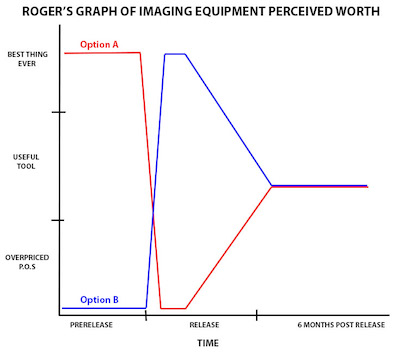
Roger Cicala, 2013
But what about new releases that really aren’t new? Usually, they fail to reach sufficient quantum energy to generate much of an opinion either way. They are the dark matter of photography, detectable only by the size of B&H’s website.
It has been my pattern, over the years, to slam any manufacturer that slaps a ‘II’ or ‘III’ on a product with no real changes except in the price. Sure, you changed the coatings or cosmetics, because you either changed suppliers or your manufacturing process. And now you want $300 more for the lens.
Canon ‘refreshed’ the ever-so-popular 70-200mm f/2.8 lens from a ‘II’ to a ‘III’ with new optical coatings and paint, but no major changes. While the price is higher than the current II, it actually is the same price as the II was sold at for most of its life. A meh moment for almost everyone except those who scooped up the ‘II’ at reduced prices.
I did wonder if perhaps there might be a bit more under the hood than what Canon had announced. These are arguably the most popular lenses Lensrentals.com stocks; hundreds of copies with constant turnover. Since we do in-house repairs, over the years we’ve noticed some minor upgrades that have taken place; an internal ring and some gears have changed, etc. Internally, the 70-200mm f/2.8 is also one of the ugliest bits of engineering in the Canon fleet. We can understand why it had to be that way; it’s an incredibly complex lens. But we figure this bothered Canon’s optomechanical engineers as much as it did us, so maybe they snuck some changes in.
But let me be clear, Canon made no claims that the Canon 70-200mm f/2.8 IS III is anything more than some fresh paint, a few new labels, and some heavily marketed coatings that are what they’ve changed all their lenses to anyway. (As an aside, we despise the new fluorine front and rear coatings and consider them a significant step backward in durability; but that’s just our opinion.)
While we take Canon 70-200mm f/2.8 IS II lenses apart almost every day, we’ve never published a teardown. So, having made a short story long, we decided to do side-by-side teardowns of the 70-200mm f/2.8L IS Mk II and 70-200mm f/2.8L IS Mk III lenses to see if there was any difference in the mechanicals. Probably there aren’t, but we had some hope. (Hope: a down payment on real estate in the Land of Eternal Disappointment.)
So for this exercise, we did a full teardown on a Mark II, then repeated it on the Mark III.
Opening Up the Mount End
If you compare the 70-200mm f/2.8 Mk II to most other Canon lenses, the back (mount) end of the lens, well, it isn’t pretty. There are a lot of wires, a clumsy centering mechanism, shims, and all kinds of things that Canon has gotten away from in their other lenses. It works fine, but it’s crowded, complicated, and kind of a pain to work on.
Canon 70-200mm f/2.8 IS Mk II
The one nice thing about disassembling the back end of the Mark II is the light baffle just pops right out.
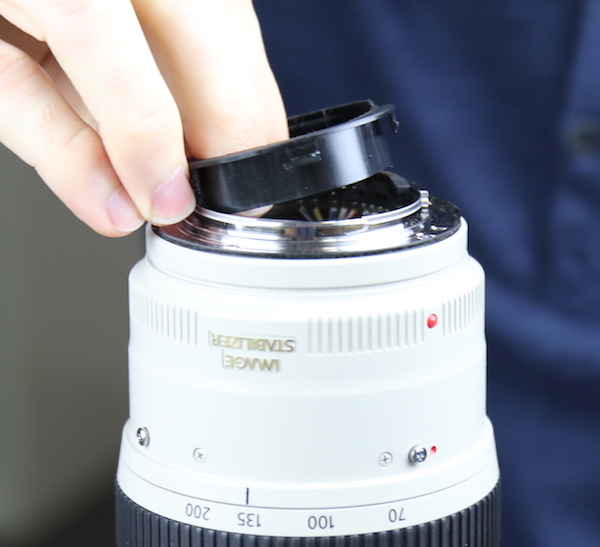
Lensrentals.com, 2018
After removing the screws holding the electrical connection to the bayonet, you remove the 8 barrel screws to remove the rear outer barrel (these are the ones that come loose every so often, jamming your tripod ring).
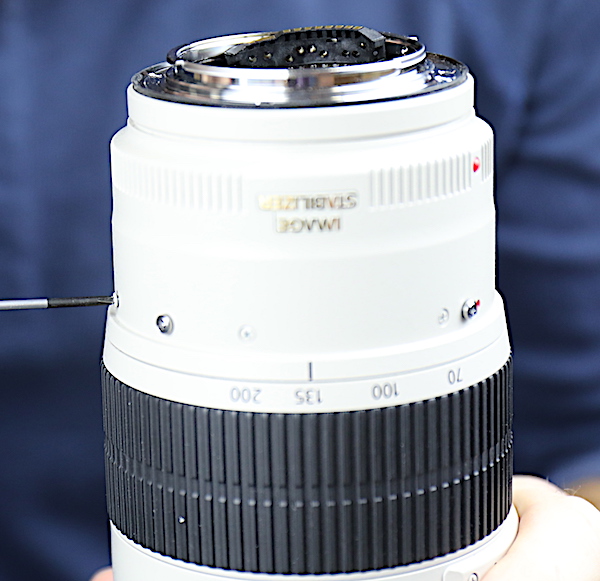
Lensrentals.com, 2018
With those out, the rear barrel slides right off. Revealing a very uncharacteristic (for Canon) wiring harness held in place by tape. Don’t mistake me; they’ve been doing it this way since the 70-200mm f/2.8 IS original version. It doesn’t cause problems, but nobody would call it elegant either.
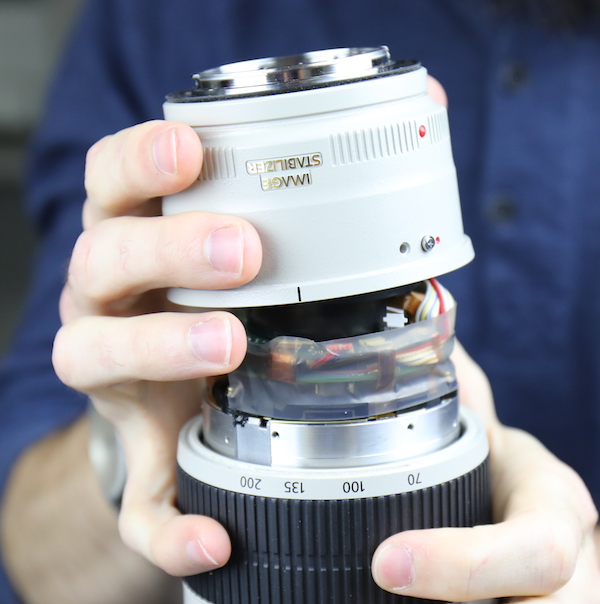
Lensrentals.com, 2018
As an aside, while the rear barrel and bayonet are most easily removed as a single piece, it is actually a 3-piece assembly. There is a spacer (red arrow) between the bayonet and the barrel that comes in various thicknesses to adjust infinity focus.
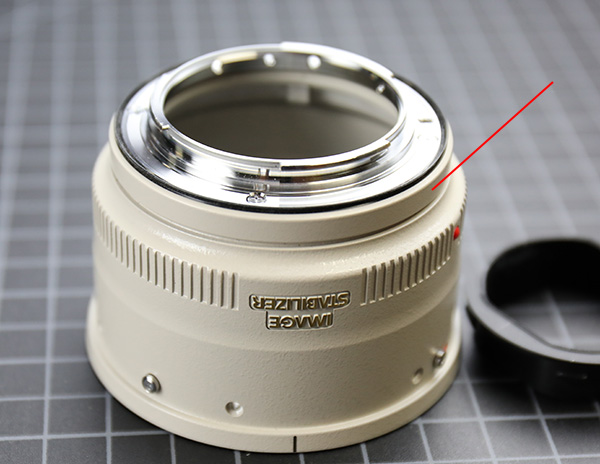
Lensrentals.com, 2018
Let’s take a closer look at the tangled electronic complexity that is the Canon 70-200mm f/2.8 IS II rear end. The only thing that would make this better would be if that was duct tape around the back. Honestly, this tape works well and lasts forever. But if you ever find yourself in this position, just take it off very carefully. You can, I’ve heard, rip a flex in two if you aren’t careful.
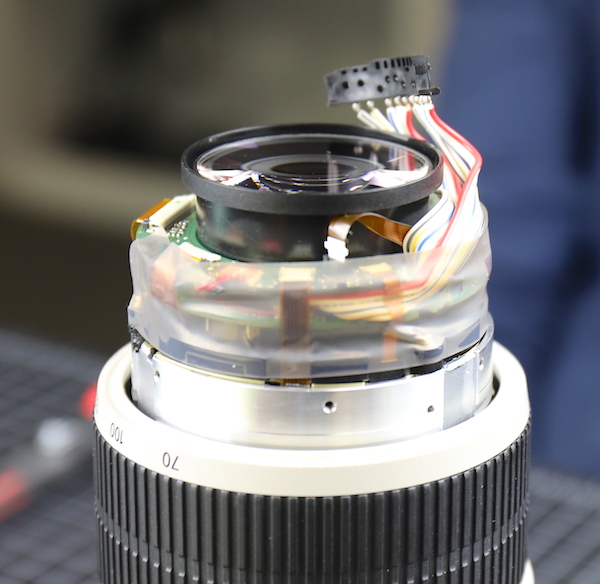
Lensrentals.com, 2018
Once the tape is off, you can see the double circuit boards, multiple flexes, and wandering wires that make this lens not much fun to work on.
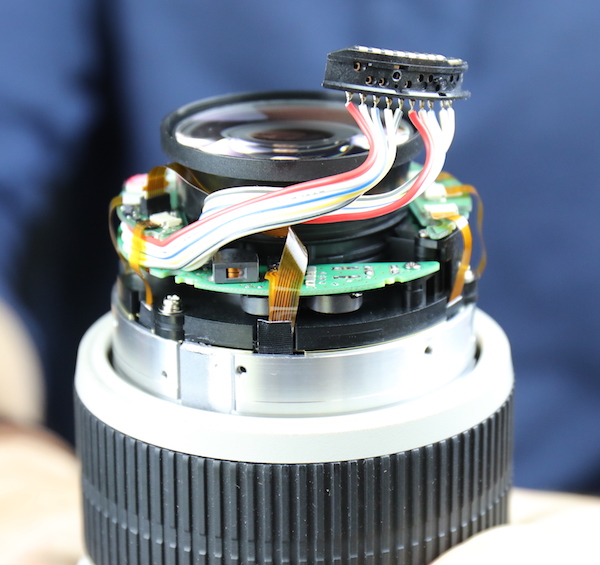
Lensrentals.com, 2018
On the other side, we have a close up of one of the three ‘screws of the dark abyss’ that hold this rear assembly on to the rest of the lens (that’s it, sitting right above the 135 marker on the zoom barrel). Note to those of you who want to take your 70-200 f2.8 IS apart: once you remove those screws you are well and truly… going to have to do a lot of optical adjustments. But more on that later.
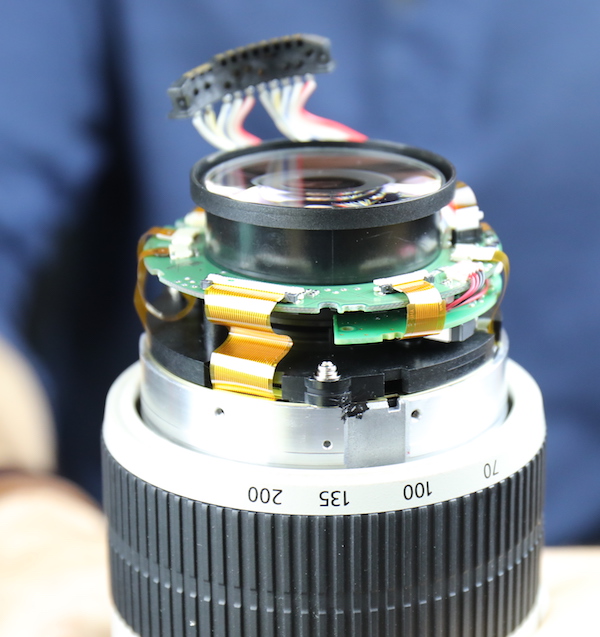
Lensrentals.com, 2018
Canon 70-20mm f/2.8 IS Mk III
So, same rear baffle.
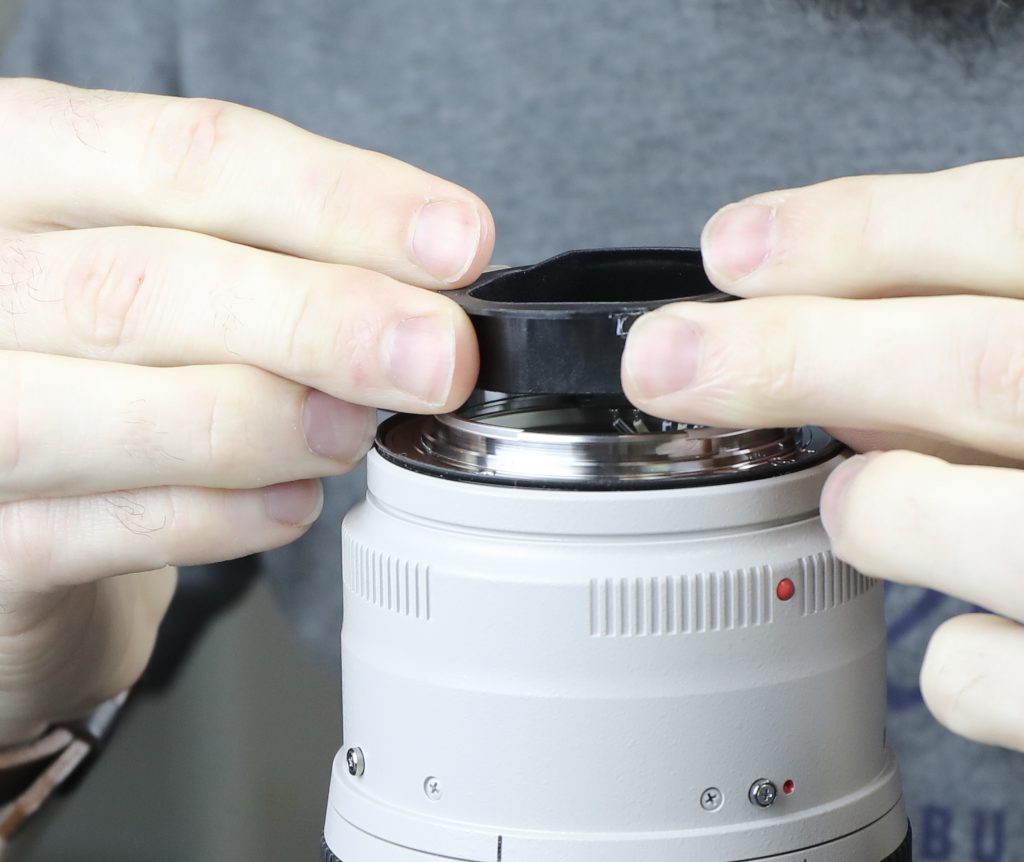
Lensrentals.com 2018
Same mount and rear barrel that comes off the same way.
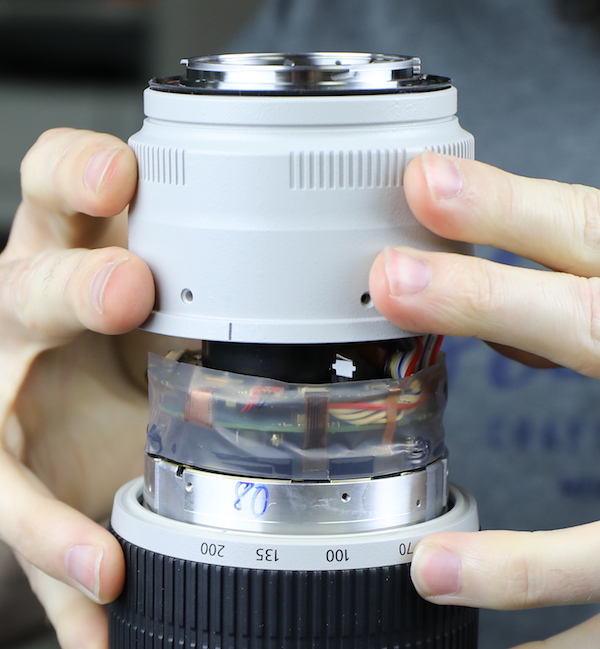
Lensrentals.com 2018
Same wire harness and circuit boards underneath.
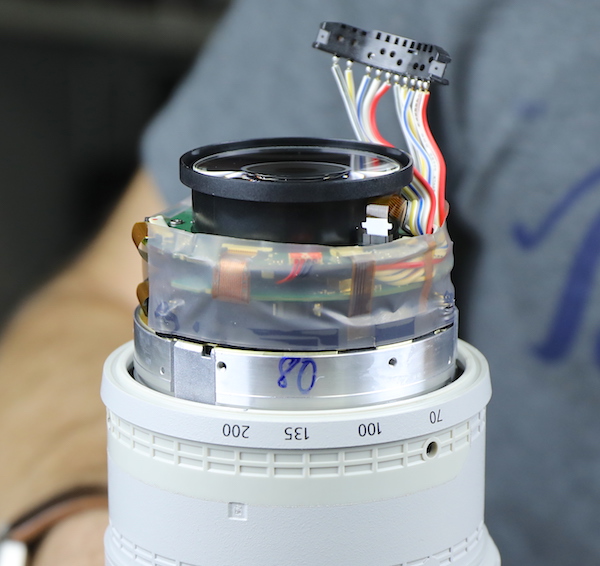
Lensrentals.com 2018
We took the tape off and looked around, but rather than clogging up more bandwidth with pictures; it’s the same rear centering and spacing system as before; if you want to see the internal parts of the Mk III, just look at the Mk II pictures.
Zoom Mechanism
Canon 70-200mm f/2.8 IS Mk II
Peeling away the zoom rubber shows the actual zoom barrel and the screws that hold it on to the actual zoom mechanism inside. This is one of the parts that have changed over time. Early versions of this lens had a smooth zoom barrel, but later versions had the waffle-grip that newer Canon lenses have, like this one. Yes, we’ll wait while you peek under your zoom rubber to see which kind yours is.
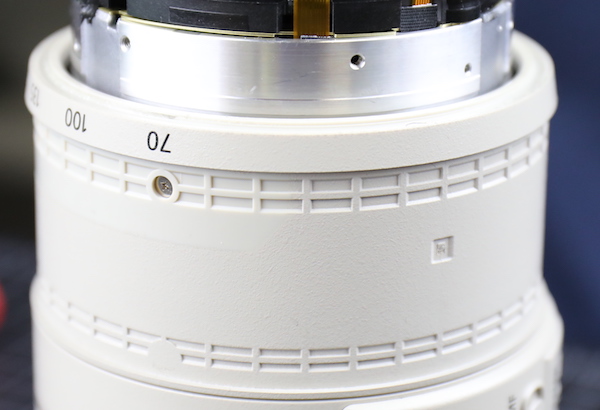
Lensrentals.com, 2018
Removing those screws lets us slide the outer zoom barrel off, exposing the reverse gear mechanism. You can see the screw hole in the outer barrel directly above the screw hole in the black inner rotating ring.
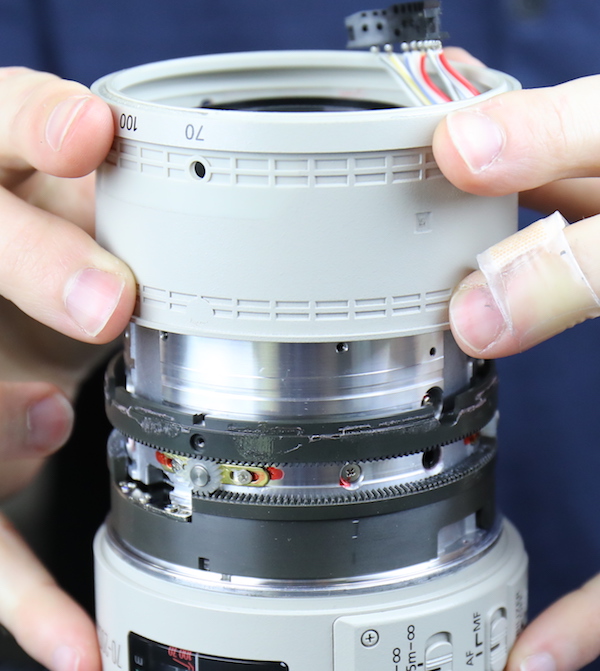
Lensrentals.com, 2018
The reverse gears purpose is so when you turn the zoom ring in one direction; the actual zoom mechanism turns the other direction. ‘Cause, you know, why make something simple when you can add a bunch of gears and teeth? Actually, it does have a purpose. The reverse gears are adjustable and help keep the zoom motion smooth and with just the right amount of resistance.
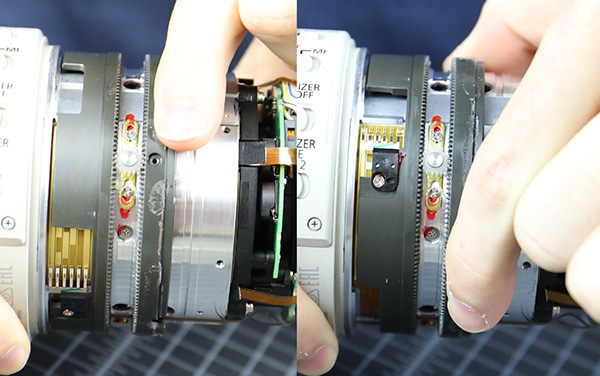
Lensrentals.com, 2018
And let’s show a quick look at the Canon 70-200mm f/2.8 IS Mk II with the rear outer barrels removed before we start taking things apart.
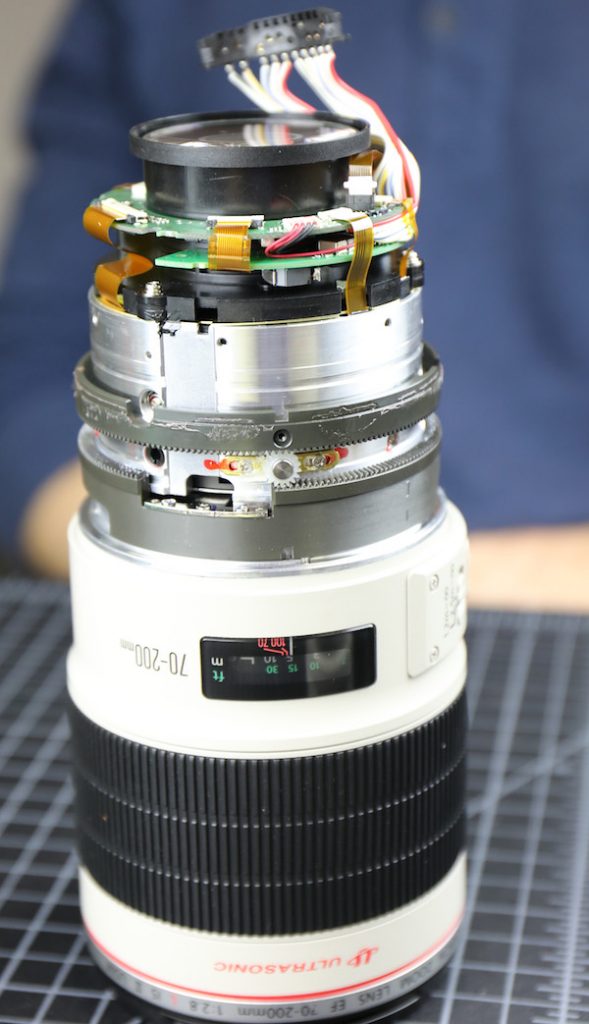
Lensrentals.com, 2018
Canon 70-200mm f/2.8 IS Mk III
Again, the zoom barrel comes off the same way. The reverse gears, position brushes, and tension mechanisms are all the same.
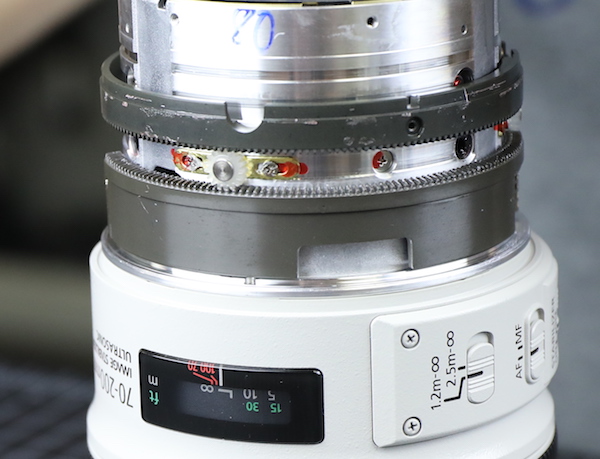
Lensrentals.com, 2018
My real hope for a change in this lens was that we would see the eccentric optical adjustment collars would have incremental marks like the ones we saw in the Canon 70-200 f/4 IS Mk II, indicating some computer-aided optical adjustments. Alas, in this group at least, the eccentric collars were just as they have been, as are the roller bearings.
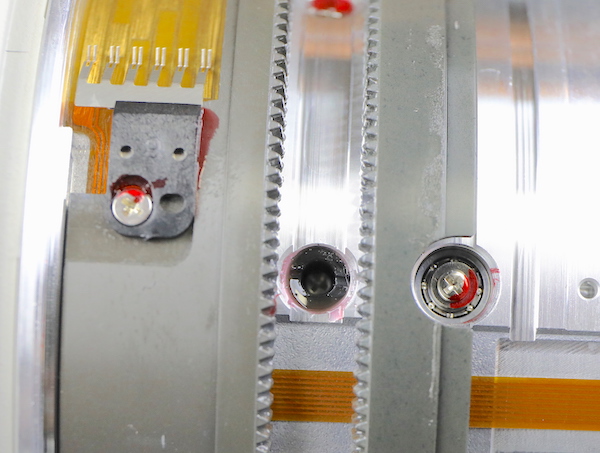
Lensrentals.com, 2018
Rear and IS Groups
Canon 70-200mm f/2.8 IS Mk II
So it’s time to remove the screws of the dark abyss that hold the rear group onto the lens barrel. Once those are out, and the flexes carefully moved out of the way, the rear assembly comes right off. There are spacing shims underneath, usually two or three of various thicknesses. These are not infinity spacers but are of optical importance.
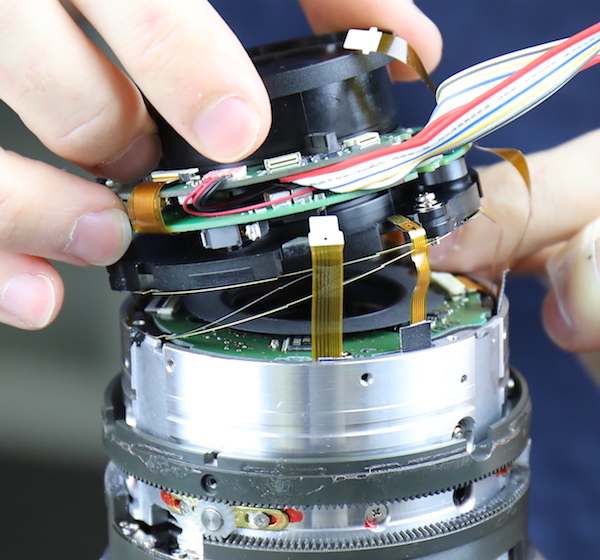
Lensrentals.com, 2018
The entire rear group is a centering element and a bit of a pain for us to adjust: we have to estimate the centering move, then reassemble and test and often disassemble and readjust. It’s not hard if you have the right equipment, but it is time-consuming.
There’s a flex going into the IS unit that has to be disconnected before setting the rear group aside.
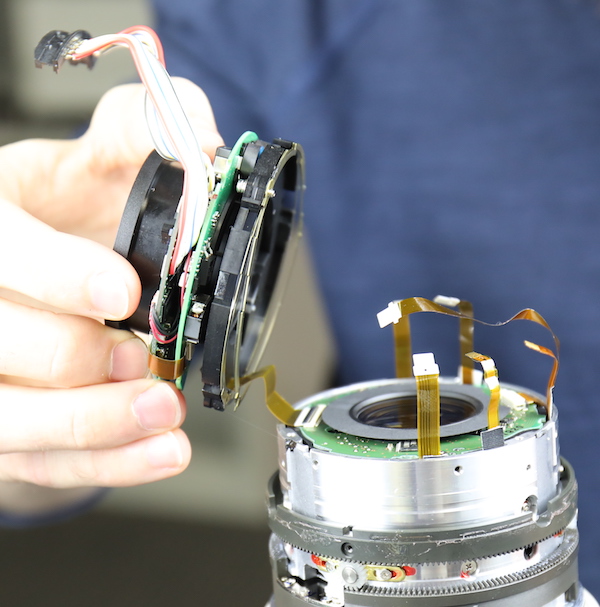
Lensrentals.com, 2018
But now we have a nice look at the top of the IS unit, along with its circuit board.
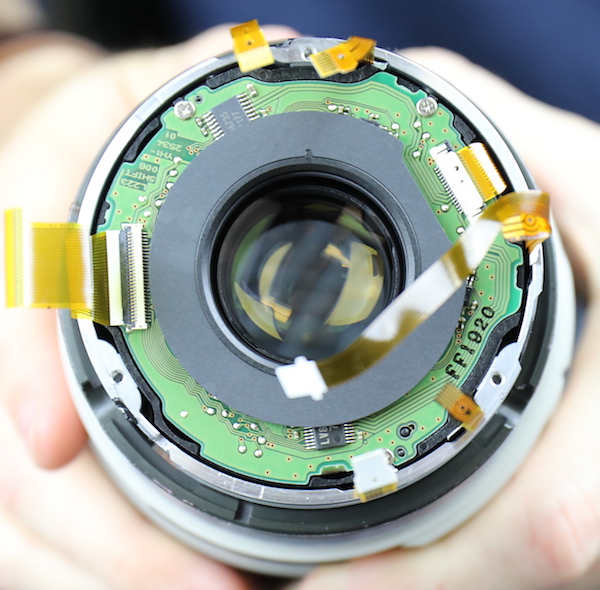
Lensrentals.com, 2018
The IS group is held in place with three, three-piece roller assemblies. The screw is removed (see the opening centered below) but then a small extractor is needed to get out the roller and post.

Lensrentals.com, 2018
Below is one assembly together and the three pieces that make up another one, just above and out of the plane of focus. It’s a robust bit of hardware, but I assume IS units stress hardware a bit, so that seems like a good idea.
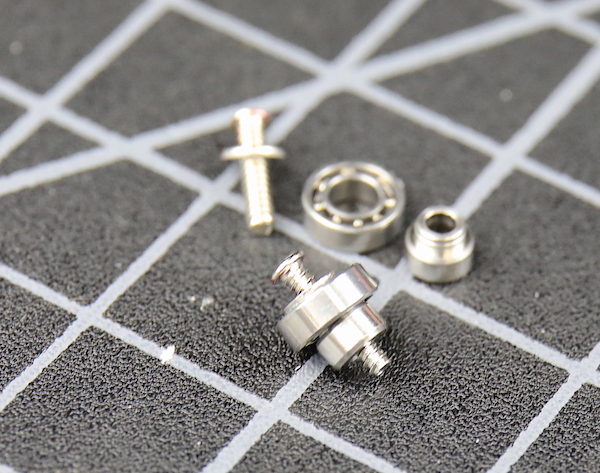
Lensrentals.com, 2018
Once those are removed, the IS unit slides out of the barrel.
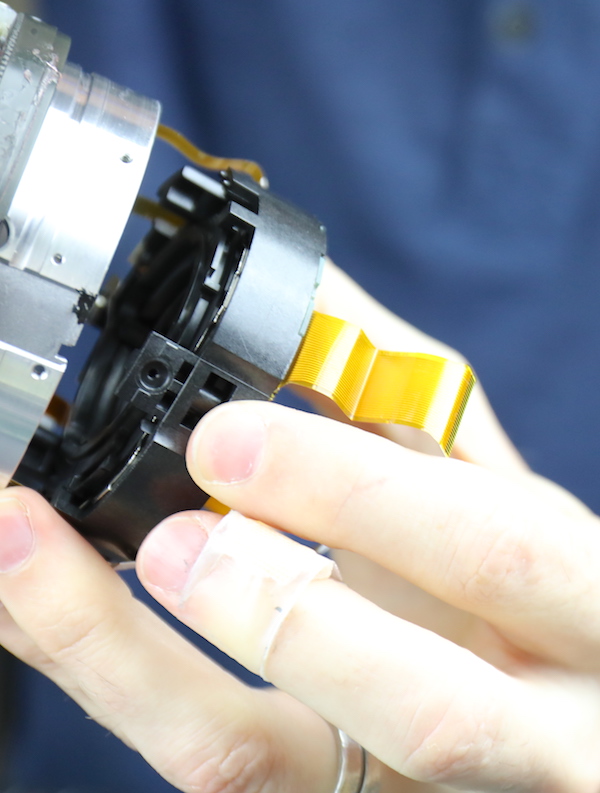
Lensrentals.com, 2018
These are self-contained units that we generally don’t disassemble.
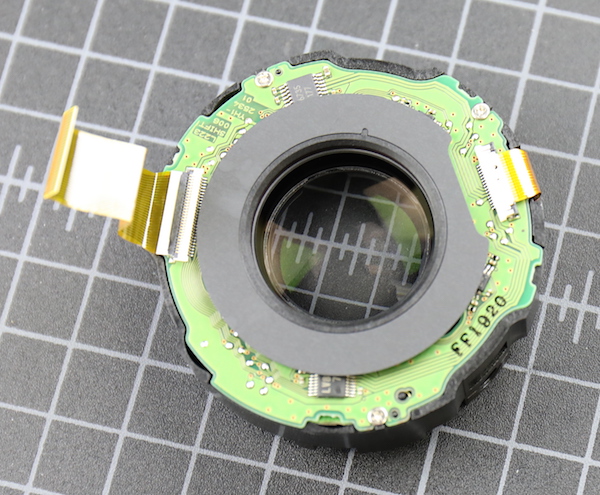
Lensrentals.com, 2018
Looking from underneath, though, you can see the plastic posts that we sometimes mention. These occasionally break, possibly from shock during shipping. If the IS is not turned off, the lens group is free to bounce in all directions with only the posts to stop the motion.
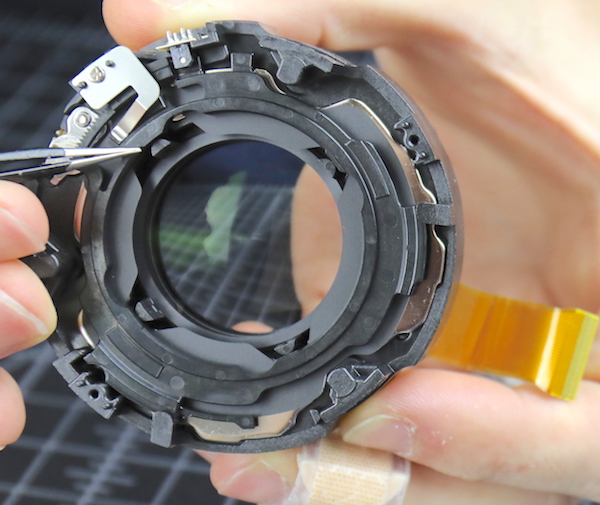
Lensrentals.com, 2018
Canon 70-200mm f/2.8 IS Mk III
Again, I won’t clog bandwidth. The internal components back here are the same.
Mid Barrel Disassembly
With the IS unit removed, we are looking down at a single optical element in the mid barrel. It’s just behind the aperture assembly; you can see the aperture motor peaking up through an opening at the bottom of this picture.
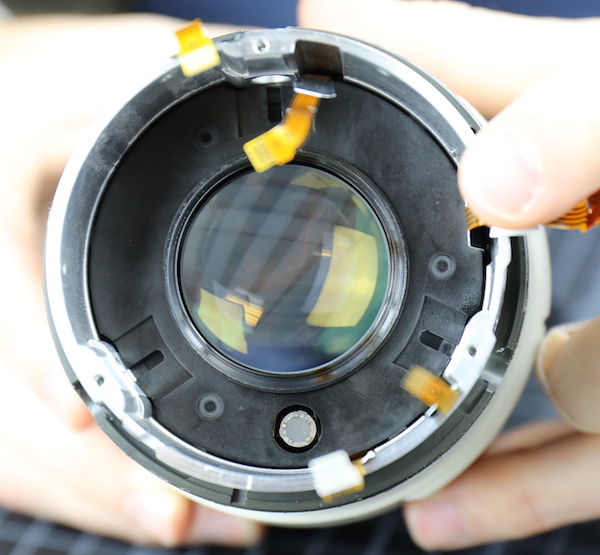
Lensrentals.com, 2018
This element is adjustable for tilt, so both screw and black plastic eccentric collar have to be removed to take it out.
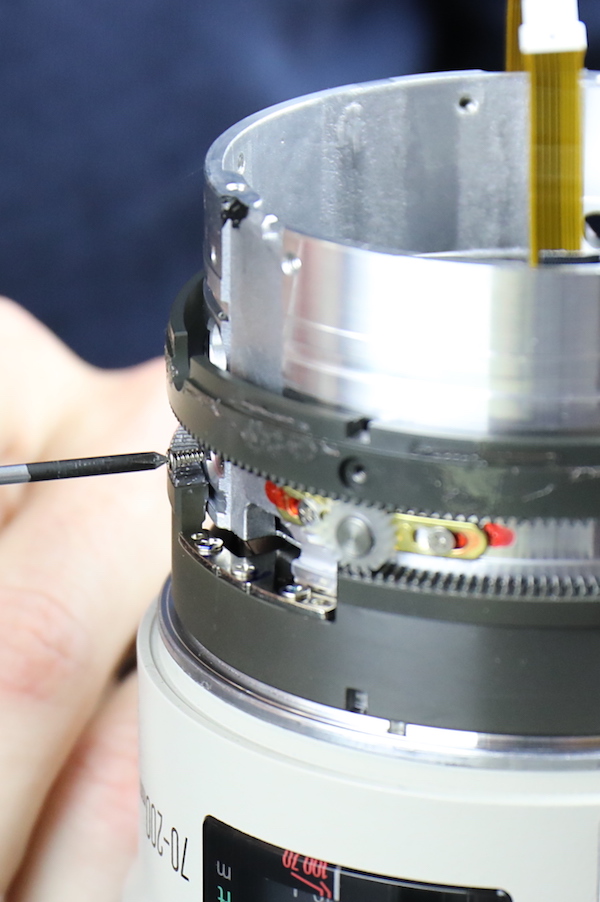
Lensrentals.com, 2018
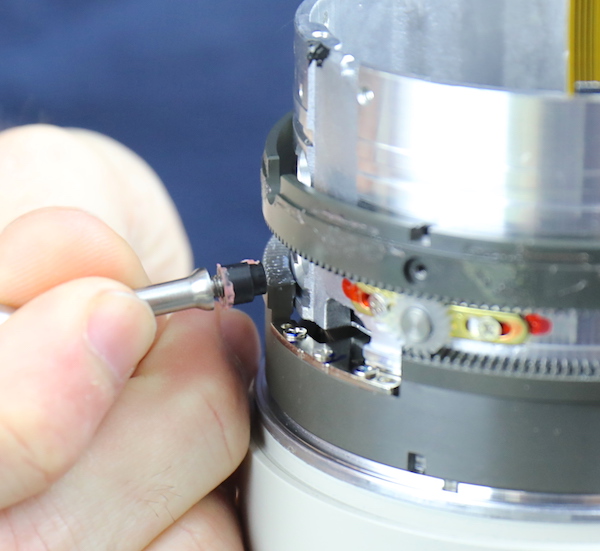
Lensrentals.com, 2018
Once these three assemblies are out, we can remove this element from the barrel.
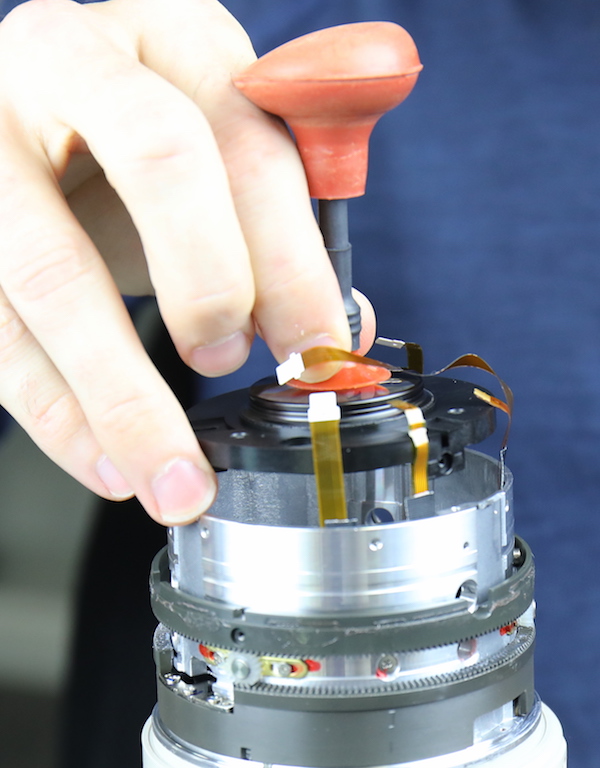
Lensrentals.com, 2018
Now we have access to the aperture assembly.
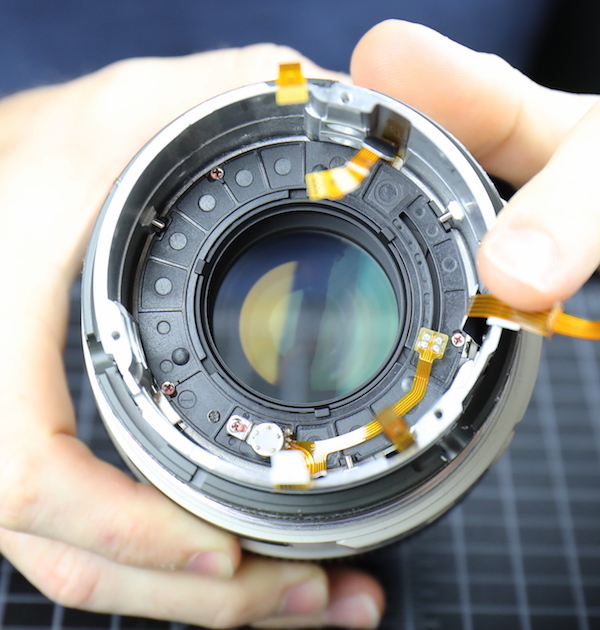
Lensrentals.com, 2018
Removing three screws lets us take the aperture assembly out of the barrel.
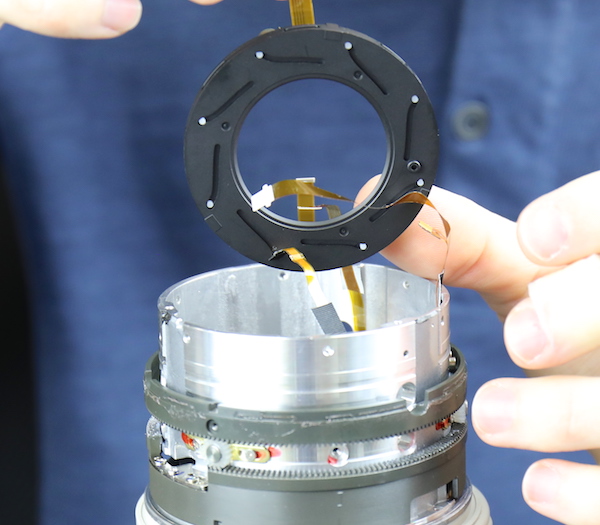
Lensrentals.com, 2018
With the aperture assembly removed we can now see the eight screws that attach the rear barrel to the front.
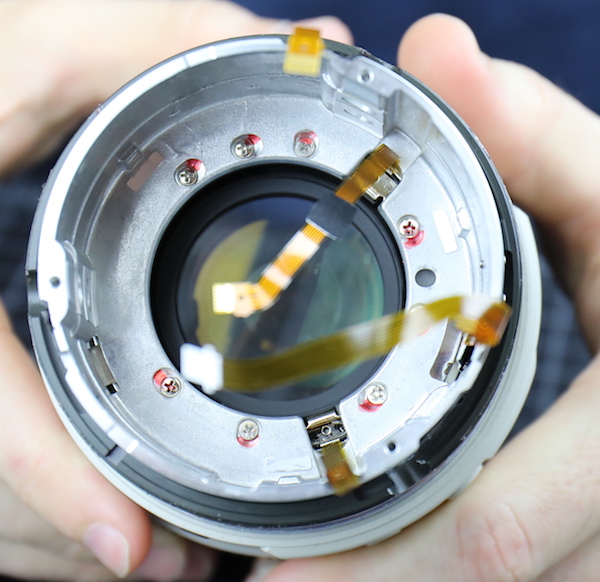
Lensrentals.com, 2018
After removing those, we can slide the rear barrel off the remainder of the lens. That’s the AF motor you see under Aaron’s fingers.

Lensrentals.com, 2018
The rear barrel is empty now except for the switch panel. This could now be removed from the outside, but there’s no reason to do that.
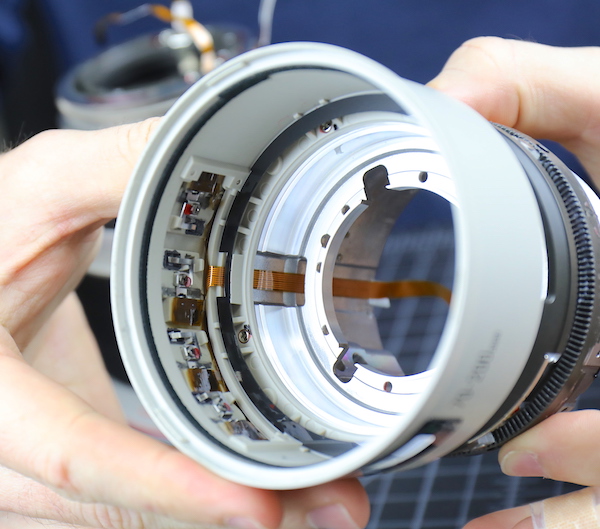
Lensrentals.com, 2018
The remainder of the lens contains most of the glass elements and the AF motor.
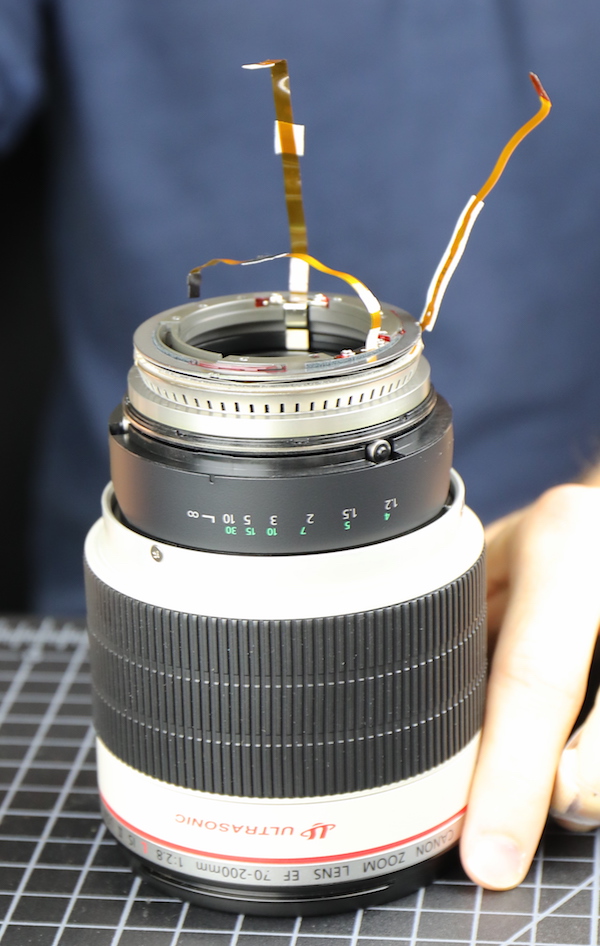
Lensrentals.com, 2018
Canon 70-200mm f/2.8 IS Mk III
Ditto
Front Disassembly
Of course, the rubber comes off first.
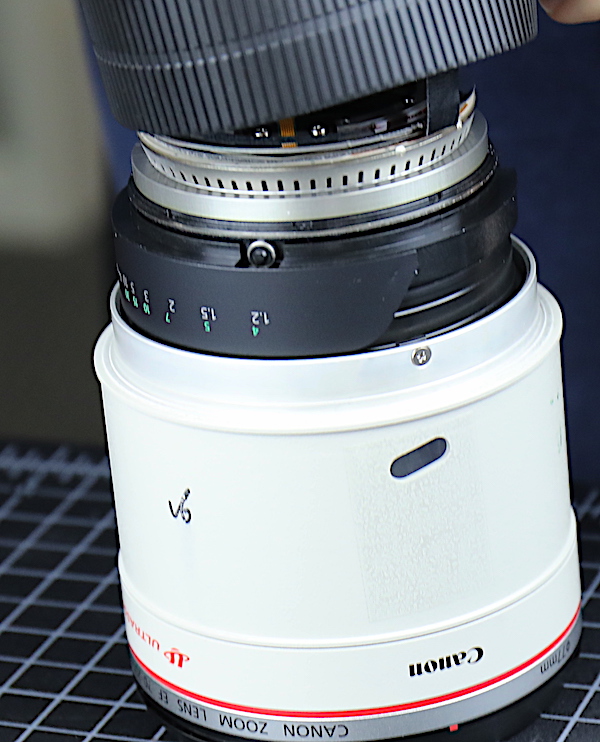
Lensrentals.com, 2018
Underneath we find the only slot-head screws the lens has.
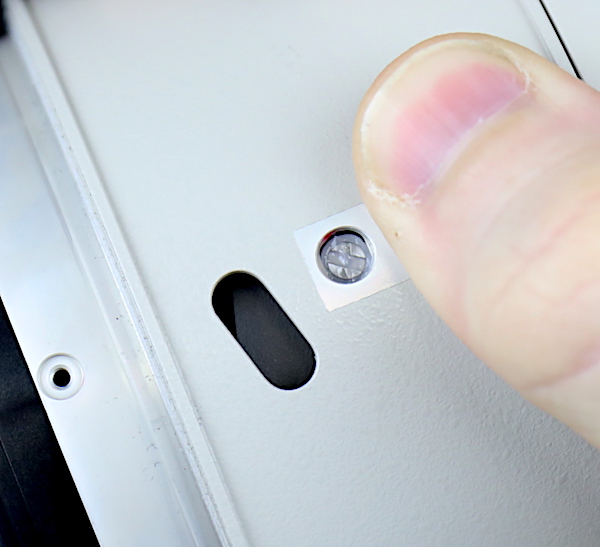
Lensrentals.com, 2018
It’s hard to tell from the image above, but the screw is holding down a nylon collar. These impart a smooth feel to the manual focus.
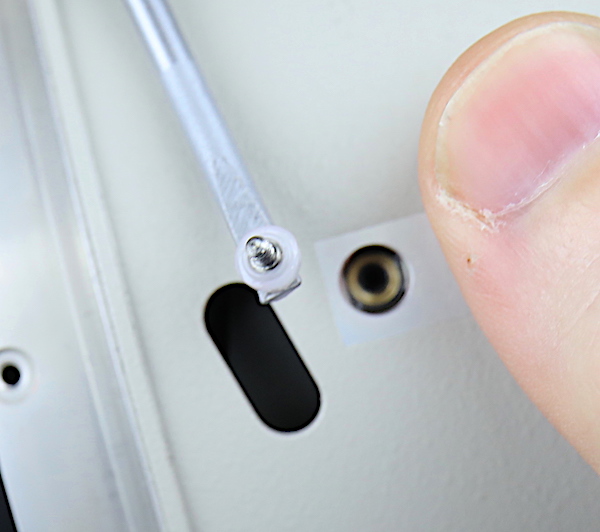
Lensrentals.com, 2018
With those out, we can remove the focus ring.
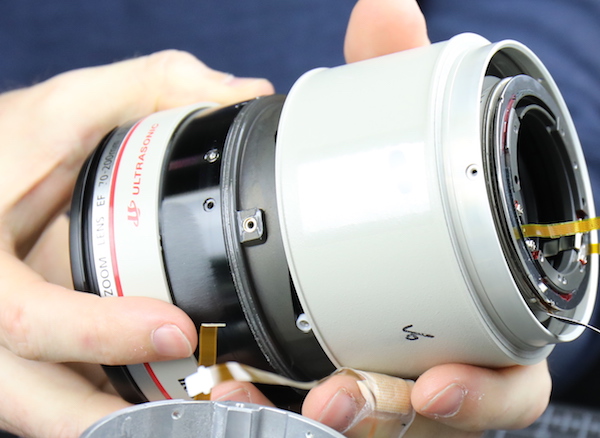
Lensrentals.com, 2018
And now we can see the inner focusing barrel. The brass screw inset is where the nylon collar was, and you can see the slots and cams for the focusing group.
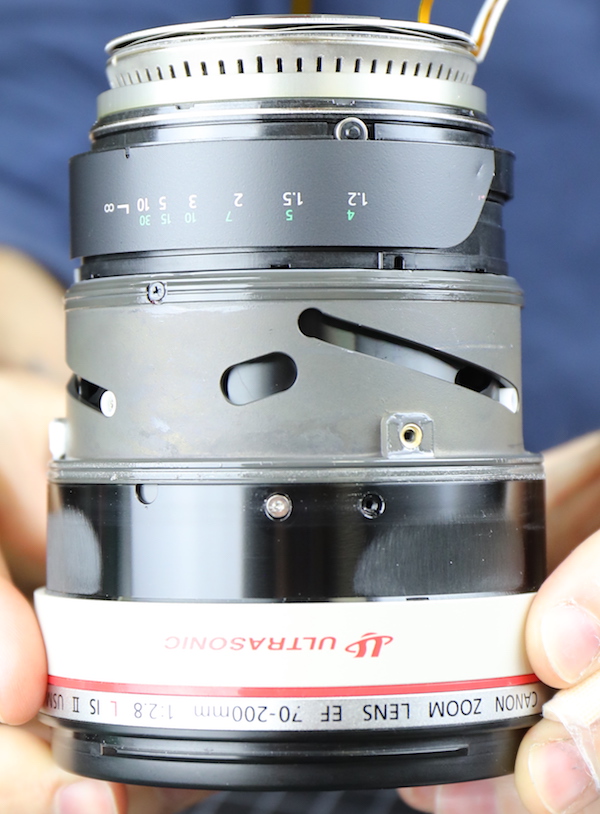
Lensrentals.com, 2018
A couple of more screws out and the filter barrel slides off. (This can be done without any other disassembly if we were replacing a filter barrel or front element. We save it till the end when doing a full disassembly so we can set the lens down to work.)
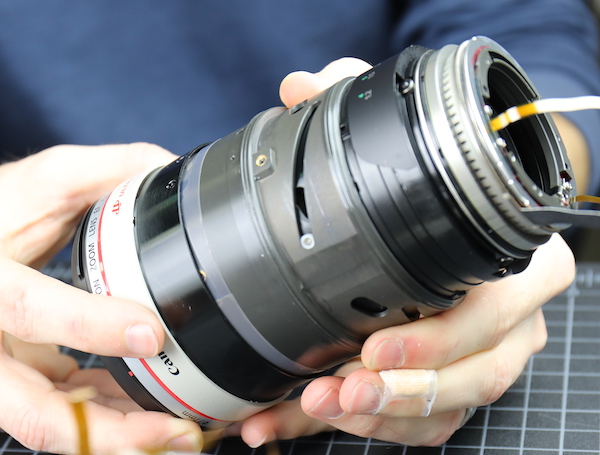
Lensrentals.com, 2018
There are two layers of weather resistance tape around the front group.
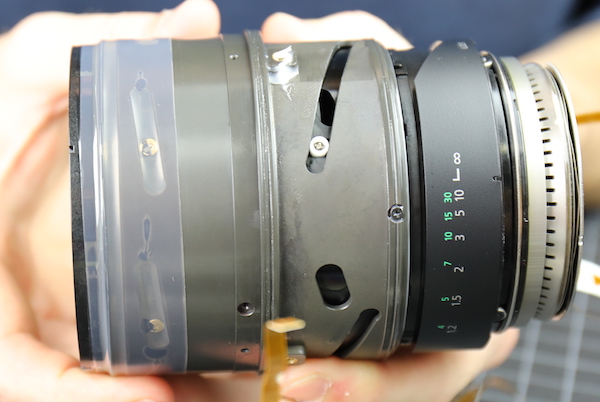
Lensrentals.com, 2018
For those of you familiar with hockey tape, it’s pretty similar to that. (Yes, by similar, I mean interchangeable with.)
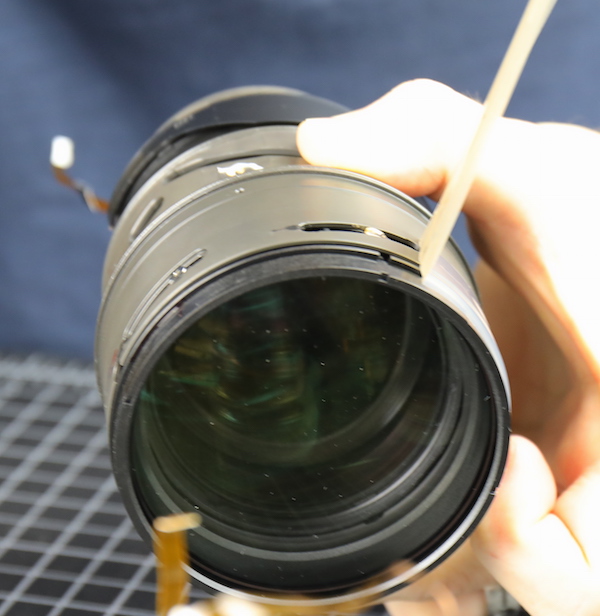
Lensrentals.com, 2018
Now we’ve exposed the screws holding the front group assembly in place. This is a place we go a lot, whether to replace a scratched front element, clean out some dust, or make an optical adjustment. There are two sets of screws that adjust the group and hold it in place.
The first set of three (only one shows in the picture) is set in a ramp. Loosening them and turning the front group adjusts the spacing between the front group and the rest of the lens.

Lensrentals.com, 2018
The second set is three eccentric collars (again, only one showing), used to adjust the tilt of the front group.
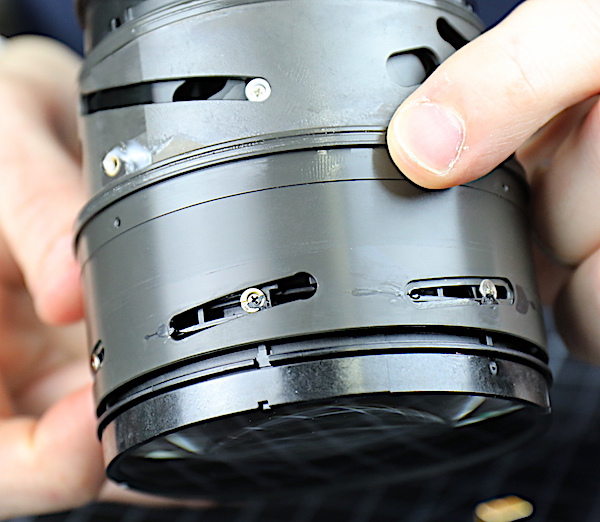
Lensrentals.com, 2018
There’s one more set of adjustment screws for the focusing group we can see down under the focus barrel.
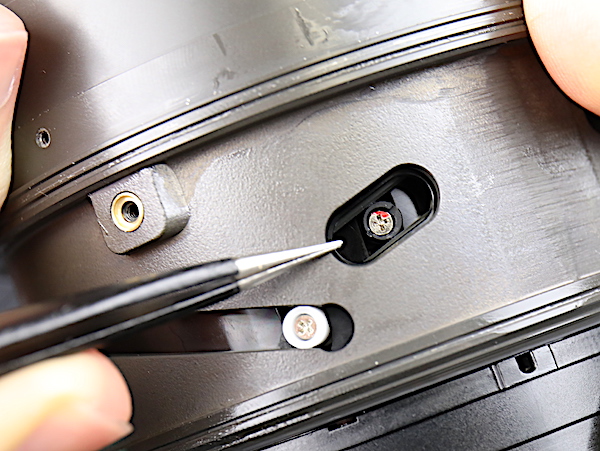
Lensrentals.com, 2018
We didn’t see any reason to take the AF motor apart or remove the front group. We can see everything there is to see except for a set of adjustment screws for the zoom group that are under the focusing motor. It’s certainly enough for comparison purposes.
To kind of summarize how many optical adjustments Canon has built into this lens:
- Rear spacer for infinity focus
- Optical spacing in front of the rear group.
- Centering of the rear group with the rest of the lens
- Tilt adjustment of middle element
- Zoom group adjustment under focusing motor
- Focusing element adjustment
- The spacing of front group
- The tilt of front group
Canon 70-200mm f/2.8 IS MK III
There is a different focusing barrel on the Mk III with the newer waffled pattern. I got a bit excited, but the Aaron told me he’d seen several recent vintage Mk IIs that also had the newer barrel.
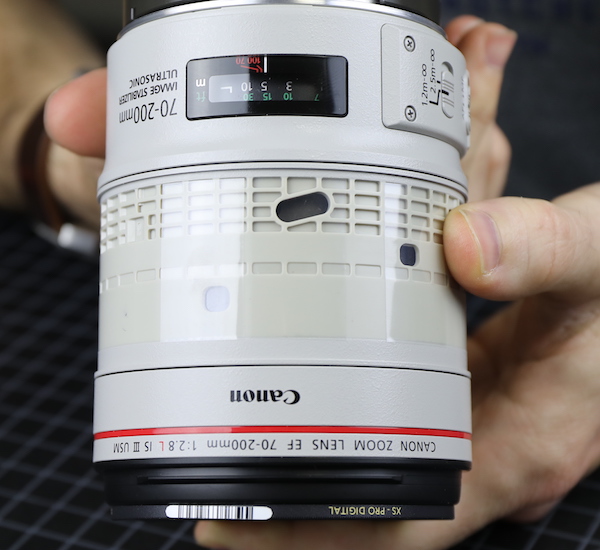
Lensrentals.com, 2018
Again, all of the disassemblies of the front was exactly the same as with the Mk II, so I won’t bore you with details. The optical adjustments of the front and focus groups were unchanged also.
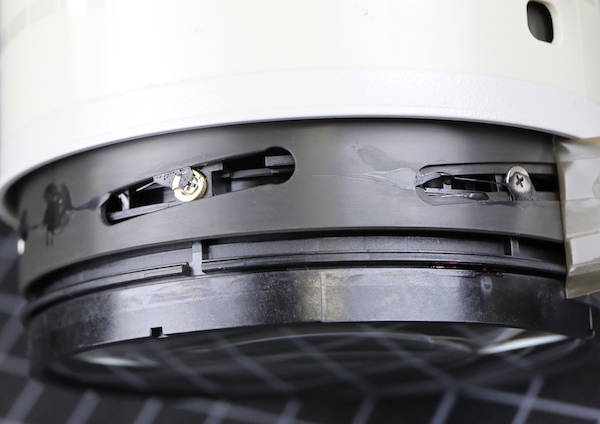
Lensrentals.com, 2018
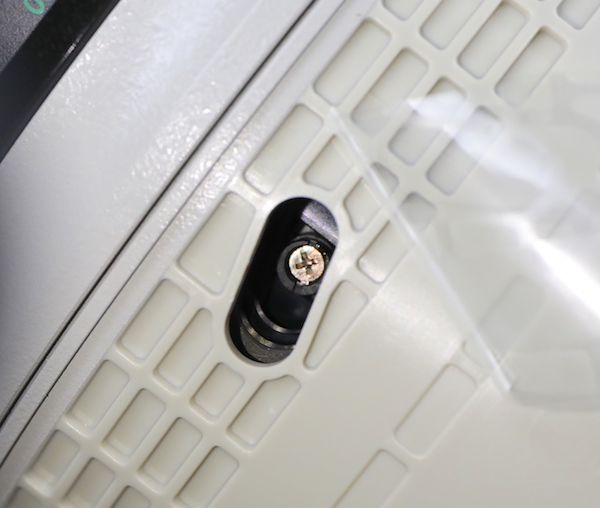
Lensrentals.com, 2018
Conclusions
Well, as Canon stated, there is no difference between the Mk II and Mk III versions. If you think there’s an optical or performance difference, please contact me about some Tennessee Beach-front property I have for sale. If you’re in the market for one of these in the near future, I’d snap up a Canon 70-200mm f/2.8 IS II at discount price if you can find it.
If you really like the new color do what we do for touchup paint: take the tripod ring from your friend’s Mk III to your local paint store and have them color match some enamel for you. Canon claims the new fluorine coating makes it easier to wipe off oil and smudges. I think the new fluorine coating is easier to wipe off. Could be Canon and I are both right, could be just Canon is right.
As to the Canon 70-200 f/2.8 Mk two-three, it’s still a really excellent lens. It’s not pretty or elegant inside, but then, neither are most other manufacturer’s lenses. It takes great images, that’s what matters. Unless you are a Geek from the engineering-can-be-art school.
Roger Cicala and Aaron Closz
Lensrentals.com
September, 2018
Author: Roger Cicala
I’m Roger and I am the founder of Lensrentals.com. Hailed as one of the optic nerds here, I enjoy shooting collimated light through 30X microscope objectives in my spare time. When I do take real pictures I like using something different: a Medium format, or Pentax K1, or a Sony RX1R.
-
Roberta Olenick
-
Hank Roest
-
Slavik @ geardads.com
-
Fabio Riccardi
-
Michael Steinbach
-
Philippe
-
David
-
ITN
-
Eric Calabros
-
Eamon Hickey
-
CheshireCat
-
Jon Rolfson
-
Chris Keats
-
Peter Marcus
-
Peter Marcus
-
AJ Borromeo
-
DrJon
-
Michael Steinbach
-
Roger Cicala
-
margo2000
-
Chris Charles
-
Roger Cicala
-
DrJon
-
Abimanyu Boentaran
-
David
-
Roger Cicala
-
Michael Steinbach
-
Roger Cicala
-
????
-
Max Manzan
